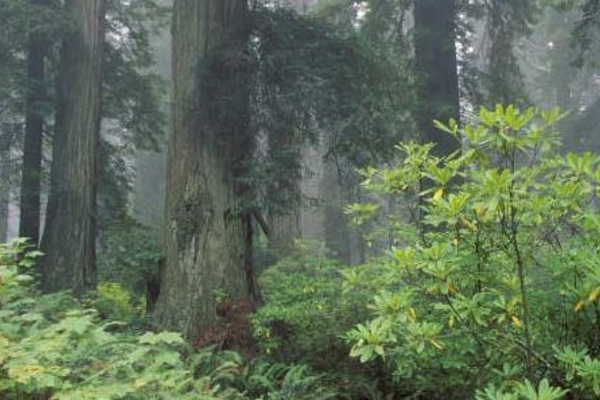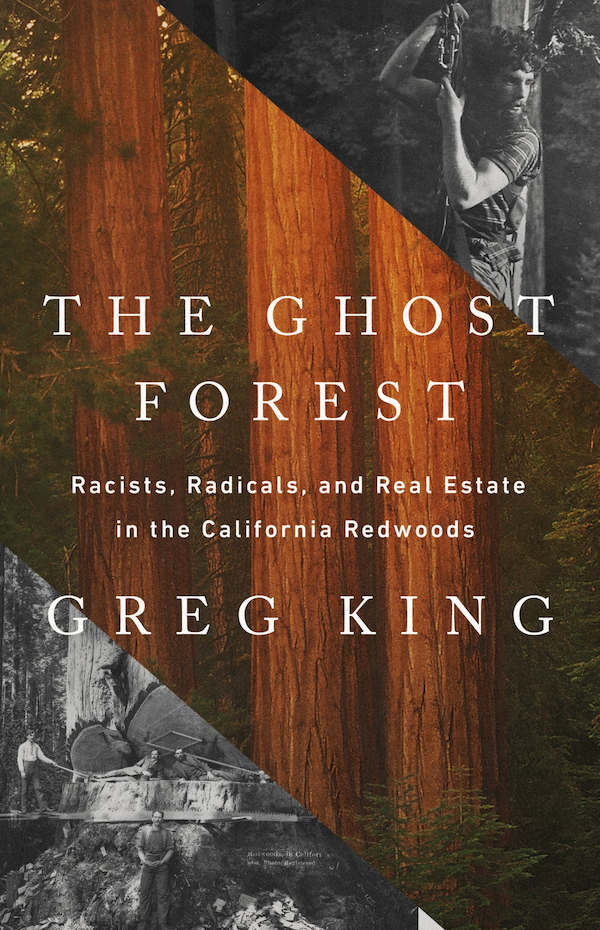California's Collusion with a Texas Timber Company Let Ancient Redwoods be Clearcut

Old-growth redwoods, Headwaters Forest Reserve (CA)
In 1985, fresh out of college, I took a job as a reporter in my hometown of Guerneville, a small village set alongside the Russian River in western Sonoma County, California. Among my many beats was the North Coast timber industry. At first I focused on the logging of second-growth redwood forests by international timber giant Louisiana-Pacific. Yet just three months after I’d landed that reporter’s job, a Houston company called Maxxam completed one of the most consequential corporate buyouts of the era by leveraging $754 million in high-yield “junk bonds” to purchase the 117-year-old Pacific Lumber Company.
At the time, Pacific Lumber owned the very last private inventory of old-growth redwood forest still standing outside of parks. The company’s 200,000 acres of forestland included 8,000 acres of virgin redwood, and 56,000 acres of “residual” old-growth redwood forest. It was the single largest expanse of old-growth redwood remaining in the world, inside or outside of parks.
At first I investigated Maxxam’s redwood liquidation as a reporter. But after I visited the targeted forests I quit my job and moved to Humboldt County, a coastal outback two hundred miles north. Searching for a means of saving these ancient redwood groves, I co-founded a North Coast chapter of the radical environmental movement Earth First!. Our small group of determined activists camped high into the canopy of old-growth redwood trees, blockaded roads, and occupied the Golden Gate Bridge to draw national attention to what turned out to be the illegal destruction of the last ancient redwoods.
When I wasn’t dangling from trees, I was researching and publishing, which turned up several startling discoveries. It was shocking enough that a Houston oil and real estate company could employ the services of three soon-to-be-convicted financial felons—Ivan Boesky, Boyd Jeffries, and, at the notorious junk-bond firm of Drexel Burnham Lambert, Michael Milken—to secure a hostile takeover of, and immediately set to liquidating, the world’s last ancient redwoods. But what was especially jarring was the understanding that the California Department of Forestry (CDF), which was charged with enforcing statutes designed to protect soils, streams, and habitat, would approve every one of Maxxam’s destructive timber harvest plan (THPs) no matter that most of them violated several state and federal environmental laws.
Prior to the takeover of Pacific Lumber, Maxxam’s legal eagles no doubt understood that in 1970 California lawmakers had passed an unusually effective environmental law called the California Environmental Quality Act (CEQA). Three years later the state also passed the California Forest Practice Act (FPA). At the time the Forest Practice Act was touted as a means of curbing abusive logging practices, particularly in the redwoods. More accurately, the Forest Practice Act allowed timber companies to evade the far more restrictive requirements of CEQA—no matter that such evasion was illegal, as several court challenges would prove.
CEQA required that a company proposing a “project” in California must first provide an environmental analysis that takes into consideration the potentially “significant, cumulative, adverse environmental effects” of a of that project when considered alongside “past, present, or reasonably foreseeable future” development plans in the area. This was a very high bar, especially when applied to logging, among the most cumulatively destructive activities in California at the time. Properly enforced, CEQA would have prevented the scorched-earth logging that has always occurred in California, particularly in the state’s minuscule stands of remaining ancient forest. In contrast, the Forest Practice Act required that private timber companies submit just a short, check-box “timber harvest plan” whose level of environmental review was cursory at best. The Forest Practice Act reconstituted the California Department of Forestry as an enforcement agency, but really CDF served as a bulwark to assuage and fend off public challenges to destructive logging.
In 1985 the Humboldt County-based Environmental Protection Information Center (EPIC) penetrated the bulwark by securing a state appellate court decision against timber giant Georgia-Pacific Corporation and CDF for submitting and approving, respectively, a timber harvest plan designed to clear-cut the very last 75-acre grove of virgin redwood forest (called Sally Bell Grove) on California’s famous Lost Coast. The court ruled that timber companies and CDF must comply not just with the Forest Practice Act, but also the “cumulative effects” clause of CEQA.
Nonetheless, a confederacy of state officials—from the nine-member state Board of Forestry (made up primarily of loggers, ranchers, and academics loyal to the timber industry), to the Director of CDF in Sacramento, to CDF foresters on the ground—almost to a person refused to properly enforce CEQA, or even to consider it. Department of Forestry officials were largely culled from the same forestry programs—at Humboldt State University and UC Berkeley—as were corporate foresters. They all knew each other, and some of them were related. At the time of the Maxxam takeover of Pacific Lumber, the state foresters were also under pressure from Republican Governor George Deukmejian, a great friend of the timber industry, to maintain a heavy cut. State officials stuck with the weak provisions of Forest Practice Act and approved every Maxxam timber harvest plan with dizzying haste.
At the end of 1986 I compiled a list of the fifty-two timber harvest plans that CDF had approved that year for Maxxam, for a total of 10,855 acres—more than double PL’s acreage of the previous year. Of this expanse, 9,589 acres contained old-growth forest, virgin and residual. There would be no more selective logging. This was an appalling rate of cut. Every standing old-growth tree—hundreds of thousands total—would be leveled as the amount of lumber that Maxxam extracted from the redwoods actually tripled. The cumulative environmental effects of this liquidation were certainly significant; more so, they were extreme. Whole watersheds began unraveling as ten timber crews carved abusive roads and denuded miles of terrain in the most rapid acceleration of old-growth redwood logging in history. Rivers and creeks filled with up to fifteen feet of sediment, and salmon, along with all manner of terrestrial wildlife, disappeared.
By 1986, thanks to the EPIC lawsuits against Georgia Pacific, CDF foresters were now forced to provide at least a cursory CEQA review of logging plans. Cursory became Orwellian. In approving a Maxxam clear-cut of 125 acres of virgin redwood, a CDF forester addressed CEQA’s questions of “significant, cumulative, adverse environmental effects” in this way:
Tractor logging and new road construction will contribute to surface soil erosion, but it is unlikely to be significant at this time. Mass soil movement may happen but to say that it will be significant is to [sic] early. New road construction and tractor logging may somewhat decrease water quality but only for a short time period. It cannot be judged at this time if it will be significant. This stand of old-growth timber has direct access to the public, however it cannot be judged at this time if aesthetics would be significantly impacted. No endangered species were noted during the inspection. Old-growth timber has been noted to shelter all types of plants and animals. Unless one observes these species it cannot be judged if any significant impact would occur.
Department of Forestry officials specialized in throwing wildlife under the bulldozer. Incredibly, they often argued in Orwellian fashion that wildlife would “benefit” from the destruction of the extremely rare virgin redwood groves held by Pacific Lumber. “A general short-term improvement for wildlife habitat is seen from this plan,” CDF wrote of a 294-acre old-growth redwood logging plan on Chadd Creek, adjacent to Humboldt Redwoods State Park. Likewise, a “possible minor improvement to wildlife habitat” would result from an 88-acre clear-cut of old growth on Corner Creek, and “wildlife habitat may be improved” after 309 acres of old-growth clear-cutting on Larabee Creek. On Strongs Creek, where Pacific Lumber would clear 760 acres of old-growth redwood, “Some deer habitat will be improved.”
In May 1987 I attended a CDF “review team meeting,” during which state foresters examined two Maxxam timber harvest plans that proposed clear-cutting 274 acres out of the heart of 3,000-acre Headwaters Forest. I had discovered and named Headwaters Forest just two months earlier. Headwaters was the largest remaining island of virgin redwood forest still standing outside of parks; the value of its old-growth habitat was undeniable. Headwaters Forest stood as the only ancient forest remaining in the Humboldt Bay watershed, and it was one of the most important breeding areas for the endangered marbled murrelets.
During the review team meeting, I asked Stephen Davis, the Humboldt County-based CDF forester who reviewed Maxxam’s new logging plans, about the cumulative effects of logging Headwaters Forest. Davis was sanguine. He saw nothing amiss in the ecological dismantling of the grove. On paper, prior to the meeting, Davis had whipped through CDF’s “Cumulative Impacts Checklist” for the THP (positioned as an afterthought at the end of the review document after EPIC’s court victory) as if he were renewing a driver’s license. A checklist question asked whether the clear-cutting would cause “significant adverse cumulative environmental effects…to fish or wildlife or their habitat.” Davis had answered, “No. Minimal impacts will occur to these values; some wildlife may benefit.”
Davis was sitting directly across from me. I pulled out a cassette recorder, turned it on, and placed it on the table in front of Davis. Reading over Davis’s cumulative impacts checklist, I asked him, in the language of the California Environmental Quality Act, if clear-cutting nearly 10 percent of the world’s largest remaining unprotected grove of ancient redwoods wouldn’t significantly, cumulatively, and adversely impact the rare, threatened, and endangered species that depended on the grove for survival.
“I don’t think so,” said Davis.
“You don’t think so?” I asked.
“No.”
“What makes you not think so. Once the old-growth habitat is gone, how will the wildlife species that depend on that habitat survive?”
“What habitat are you speaking of?”
“The old-growth-forest habitat.”
“Who?”
“This”—I pounded my fingers into a THP map that was on the table—“this old-growth-forest habitat.”
Davis said, “I don’t think there’s a cumulative effect on those.”
“You don’t think so? You don’t think that by eliminating old growth in general, old-growth-dependent species will also be eliminated?”
“There’s plenty of habitat out there.”
The Department of Forestry quickly approved the THPs. Just as quickly, EPIC sued. The organization won this and nearly every lawsuit that it brought against Maxxam and CDF, exposing the willingness of both a voracious Houston corporation and California officials to violate state environmental laws (EPIC would also soon win a federal lawsuit against Maxxam that enforced the Endangered Species Act). But EPIC could only litigate against individual plans—the courts refused to consider a lawsuit targeting a company’s entire operation, no matter the obvious cumulative devastation.
In 1999, the state and federal governments paid Maxxam $480 million for 3,000-acre Headwaters Forest. It was an extraordinary sum in the face of lawsuits that had locked up the grove and rendered its actual value closer to approximately $50 million. After the deal, Maxxam continued cutting virtually every remaining tree of value on its 200,000 acres until, as if on cue, in January 2007, Pacific Lumber declared bankruptcy.
In two decades Maxxam had liquidated nearly all of Pacific Lumber’s assets, valued at between $3 billion and $4 billion. Twelve hundred employees lost their jobs. Pacific Lumber still owed bondholders $714 million, virtually the same debt incurred at the time of the junk-bond takeover in late 1985. Nonetheless, Maxxam, thanks to profits realized in the liquidation of Pacific Lumber, had made the Fortune 500 list eight times between 1989 and 1998. It was a sordid, though expected and predicted, ending to brief history of ancient redwood liquidation.
This excerpt of The Ghost Forest is published by permission of Public Affairs.
